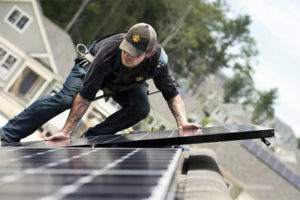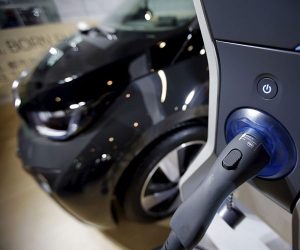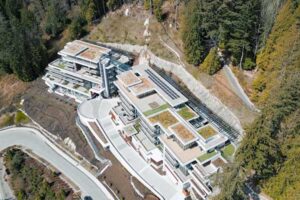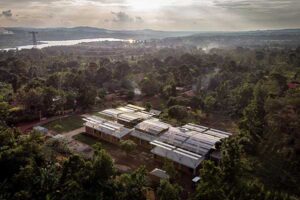Hello, PVBuzz community!
As we step into a new year, I want to reflect on some of the compelling articles that shaped our discussions throughout 2023. In case you missed them, I’ve curated a list of my favorite pieces that delve into innovative technologies, sustainable initiatives, and transformative developments within the renewable energy landscape.
These articles not only inform – they inspire. The stories offer a glimpse into the advancements that continue to drive our journey towards a cleaner and more sustainable future. Let’s revisit them stories together and reignite the enthusiasm for the incredible strides we’ve witnessed in the realm of solar energy.
1. Selling solar panel installation services to homeowners in Canada? Here’s what you need to know to gain and convert more leads.
LINK

Solar panels have become increasingly common on homes as prices have fallen. (Ben McCanna/Portland Portland Press Herald via Getty Images)
For businesses selling solar panel installations in Canada, success hinges on understanding the market and implementing effective communication. The education piece is key: from highlighting the benefits of solar technology to touching on how adopting solar will reduce carbon emissions, lower energy bills, and enhance home value. Demonstrating cost savings is also essential, by providing homeowners with estimates based on energy consumption and local electricity costs.
Clear explanations of the installation process, including timeline and necessary permits, help alleviate homeowner concerns. Offering financing options can make services more accessible and attract customers who might face upfront cost barriers. Providing ongoing support, including maintenance and monitoring, ensures customer satisfaction and the long-term effectiveness of the solar system. Overall, a comprehensive approach can help homeowners embrace sustainable energy, reduce carbon footprints, and enjoy financial savings.
Recognizing the significance of effective communication, I appreciate the emphasis on the importance of educating potential customers about the numerous benefits of solar technology.
I think the suggested well-rounded strategy for businesses to navigate the solar market also helps promote informed-decision making for homeowners considering solar. Particularly, I value the article’s focus on accessibility through financing options and the commitment to ongoing support, ensuring customer satisfaction. For homeowners, I would add that going with a local solar installer who is committed to being there if your system needs maintenance down the road is a good idea when considering which installer to partner with for your solar system.
2. Bidirectional Charging could unleash the full potential of electric vehicles — and renewable energy. But its scalability is in question.
LINK

Electric cars are advertised as having zero emissions. An electric charging cable is seen here connected to an EV (Jason Lee/REUTERS)
Bidirectional charging technology has the potential to revolutionize the renewable energy landscape by allowing electric vehicles (EVs) to consume and send energy back to the grid. While proven effective in small-scale pilots, the scalability of bidirectional charging remains a challenge. This technology enables EVs to act as distributed energy resources, offering benefits such as reduced reliance on stationary battery storage, grid support during peak demand, and storage and distribution of energy from renewable sources. Pilot projects worldwide have demonstrated technical feasibility and cost reduction in EV ownership.
However, challenges include standardizing communication protocols, ensuring cybersecurity, and overcoming technical hurdles related to batteries and power electronics. A collaborative effort involving governments, utilities, and the automotive industry is essential to unlock bidirectional charging’s potential and contribute to a sustainable and resilient energy system.
I find this article to be a refreshingly a balanced read, highlighting the proven effectiveness of bidirectional charging in small-scale pilots and its role in transforming electric vehicles (EVs) into distributed energy resources, while also candidly addressing the challenges, such as standardizing communication protocols, ensuring cybersecurity, and overcoming technical hurdles. I particularly appreciate the call for a collaborative effort involving governments, utilities, and the automotive industry to unlock bidirectional charging’s full potential.
3. Discover how this stunning condominium in Vancouver generates half its power from solar panels, reduces CO2 as much as a small forest, and sets new standards for green living.
LINK

Courtenay at 3101 Burfield Place in the British Pacific Properties of West Vancouver. (British Pacific Properties via dailyhive)
The Courtenay condominium in West Vancouver stands as a pioneering model for sustainable residential architecture, showcasing a fusion of luxury living and environmental consciousness. The seven-story building, located on the slopes of Cypress Mountain, boasts a robust solar system with 48 panels generating 23,300 kilowatt-hours of power annually, meeting half of its energy needs. The solar panels serve various functions, including heating, cooling, domestic hot water, and electric car charging. With an interactive display for real-time monitoring in the elevator lobby, residents can engage with the building’s sustainable features.
The project, by British Pacific Properties, is their first fully electrified building, eliminating natural gas use and reducing carbon dioxide emissions by approximately 159 tonnes annually. The environmentally conscious design includes high-efficiency heat pump systems, LED lighting, fiberglass windows for superior insulation, and a green roof to manage stormwater. With a layout maximizing views and sunlight for each of its 39 condominium units, the Courtenay sets a new standard for sustainable living in Metro Vancouver.
I’m captivated by the exemplary model The Courtney presents for sustainable residential architecture. The building seamlessly blends luxury living with environmental consciousness. I find the multifunctional use of solar panels for heating, cooling, domestic hot water, and electric car charging impressive along with the layout’s optimization for views and sunlight for each of the 39 condominium units. The Courtenay definitively sets an influential new standard for sustainable living in Metro Vancouver.
4. Mount Sinai Kyabirwa Surgical Facility showcases how the transformative power of solar energy can revolutionize healthcare in remote and underserved regions.
LINK

The Mount Sinai Kyabirwa Surgical Facility in Uganda by Kliment Halsband Architects is a self-sustaining facility topped with solar panels. (dezeem)
The Mount Sinai Kyabirwa Surgical Facility in Uganda represents a green revolution in healthcare and demonstrates the transformative impact of solar energy in remote and underserved regions. The facility is powered by solar panels that are designed to mimic banana leaves. It supports the local economy and incorporates natural ventilation by utilizing locally sourced red clay bricks during its construction. Advanced features include a sophisticated water system for purifying well water, rainwater collection, and a fiber-optic network enabling live surgical consultations.
This solar-powered healthcare center serves as a model for sustainable architecture and healthcare innovation, challenging norms and providing hope for a greener future in Uganda and beyond. Plans for additional self-sustaining medical facilities, including a children’s hospital and a maternity unit, aim to extend healthcare services to more underserved areas.
The Mount Sinai Kyabirwa Surgical Facility challenges conventional norms and inspires optimism for a greener future in Uganda and beyond. This story immediately captured my attention, with its unique solar system modelled after banana leaves. I absolutely love the commitment to supporting the local economy throughout the construction phase by choosing to use locally sourced red clay bricks and I look forward to seeing the completion of the proposed additional healthcare facilities powered by solar. Facilities like this one showcase the importance of renewable energy in the mission to bring reliable healthcare to remote communities.
5. Would visualizing your solar potential help quicken the decision-making process? Well, this Alberta-based startup seems to think so.
LINK

MyHEAT solar maps help users quickly identify their home’s solar potential and receive personalized rooftop financial and environmental projections.
MyHEAT, a Canadian company specializing in Heat Loss and Solar mapping solutions, partnered with Google to launch solar potential maps. These maps utilize 3D rooftop imagery and weather analysis to provide personalized estimates of solar potential for homes, helping residents decide whether to invest in solar panels. The initiative aligns with climate goals by aiming to reduce community greenhouse gas emissions.
The City of London’s Solar Map estimates that if all suitable rooftops installed solar, an additional 1.8MW of electricity could be generated, avoiding 295,000 tonnes of CO2 emissions. The best part? This tool also guides users on system size recommendations and potential rebates, fostering informed decisions and protecting Canadians from solar scams.
I find this initiative a pivotal step toward sustainability. By empowering residents with personalized solar potential estimates, system size recommendations, and information on potential rebates, the solar maps not only contribute to reducing greenhouse gas emissions but also plays a crucial role in safeguarding Canadians from potential solar scams.
I believe this innovative tool marks a positive stride in aligning individual choices with broader climate goals. Afterall, fostering informed decision-making should never be far from mind when thinking about how to increase solar adoption.
Wrap up!
As we bid farewell to 2023, I want to express my gratitude for the incredible journey we’ve shared with the PVBuzz community. Writing about the latest developments, innovations, and transformative stories in the renewable energy sector has been a truly enriching experience. The engagement, discussions, and shared enthusiasm from this vibrant community have made each article more than words on a page; the stories are part of a collective conversation about a greener future.
I am truly excited about the possibilities that the new year holds, eager to bring you more stories, insights, and fresh perspectives that will continue to inspire and inform. Thank you for being an integral part of this journey, and here’s to a 2024 filled with even more groundbreaking narratives in the world of sustainable energy.
Cheers to another year of learning, growing, and championing the cause of a brighter tomorrow!














Comments